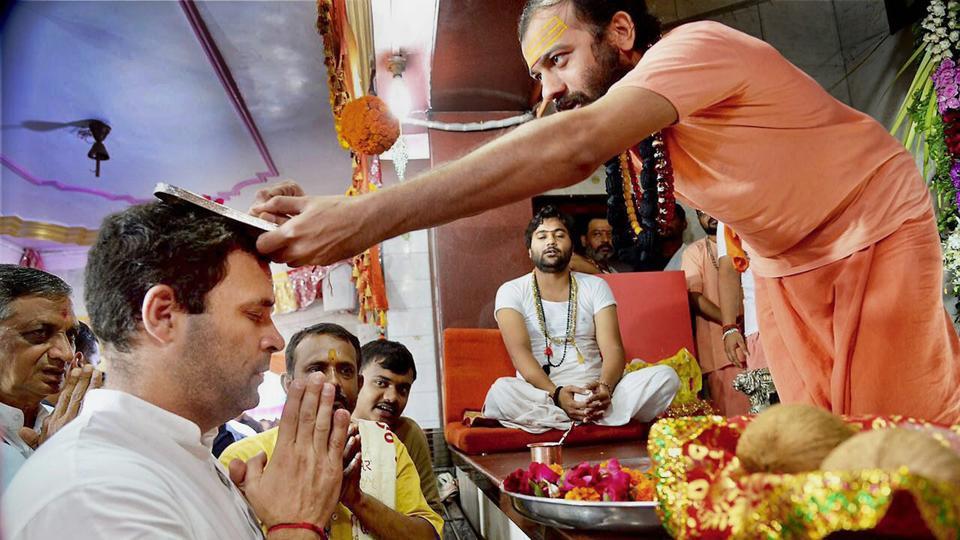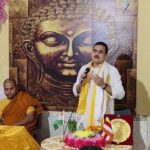RAHUL’S SOMNATH VISIT IS A GIMMICK
- By : Anirban Ganguly
- Category : Articles

Will the Congress president-elect now accept that Nehru’s opposition to rebuilding the Somnath Temple was misplaced?
Rahul Gandhi who had once declared that those who worship in temples molest women, will, it has been reported, launch his campaign for the Gujarat assembly poll from sacred and eternal temple town of Somnath. But keeping in mind how Rahul’s great-grandfather opposed the rebuilding of the temple, the people of Somnath, the custodians of the eternal shrine, ought to oppose this gimmick of temple worship that the Congress president-elect indulges in when elections are around the corner.
Rahul visiting Somnath smacks of opportunism because on a number of occasions he and his Congress party have actually denigrated Hindus and cast aspersions on them as a community. His observations on “temple worshippers molest women” is a stark example of that denigration. Rahul’s great-grandfather, Jawaharlal Nehru, too did not display high regard for temples and temples worshippers. Nehru, for example, looked on KM Munshi’s and Sardar Patel’s efforts to rebuild Somnath as smacking of “Hindu revivalism”. He snapped at Munshi in a Cabinet meeting, accusing him of being communal minded and, as Munshi recalled, at the “end of the Cabinet meeting, Jawaharlal called me and said, “I don’t like your trying to restore Somnath. It is Hindu revivalism.”
It is well-known, though that Rahul and his Congress would like us to forget it, that Nehru tried to vehemently dissuade Dr Rajendra Prasad from going ahead and inaugurating the Somnath temple once it was rebuilt. Rajen babu, displaying, as he always did in the face of Nehru’s belittling attitude, character and resolve, went ahead and dedicated the temple to the people of India, a promise he had made to the Sardar.
While Rahul’s great-grandfather opposed the Somnath temple reconstruction effort, it got wide support from a cross section of the people. Contrast Nehru’s attitude to Patel’s who threw his energies behind the project, despite a plethora of problems and challenges that needed his attention. He displayed urgency for the project to take off and come to fruition and, along with Munshi, Samaldas Gandhi, the Jam Saheb and a host of others mobilized resources, formed the trust that would oversee the reconstruction, and laid a solid network that would ensure that temple construction was completed.
Writing to Munshi in February 1950, Sardar approved the architectural design and wrote, “I shall arrange to send the donations for the Somnath Trust to its Secretary. But the work must go on at full speed.” For Sardar, the rebuilding of Somnath held a deeper significance and portent for free India’s future, it radiated a certain message that we as a people, as a collectivity and civilization needed to imbibe, internalize and establish. In his opus, Somnath — the Shrine Eternal, Munshi recalled Sardar’s deeply inspiring observations on the sea shore beside the then decrepit temple, when plans were being discussed to rebuild it. Sardar had then observed that “we would never genuinely feel that freedom had come, nor develop faith in our future, unless Somnath was restored. “Such was Sardar’s approach to the entire effort in contrast to Nehru who only perceived “Hindu revivalism” in it, instead of welcoming the project, as Sardar and Munshi had done, as a grand symbolic effort at civilizational renewal.
In fact, as Munshi observed, in the dedication of his book, it was primarily because of Sardar that the Somnath rose again, “To Sardar Patel”, wrote Munshi, “but for whom, mine eyes would not have seen the shrine of Somnath rise again.” Politically, Rahul’s great-grandfather ill-treated and marginalised both Munshi and Patel; this is a historical reality despite many an effort made to whitewash Nehru’s intolerance towards his colleagues.
On the deeper collective aspirations of rebuilding Somnath, Munshi noted, how over the aeons, “An ancient race subconsciously felt that it was Somnath which connected it with the past and the present; it was the eternal symbol of its faith in itself and in its future. As often as the shrine was destroyed, the urge to restore it sprang up more vividly in its heart.” Interestingly Swami Vivekananda, had earlier also noted the symbolism of rebuilding Somnath and all that it signified for our civilizational spirit.
In his address on the “Future of India” delivered in Madras, the Swami observed: “Some of these old temples of southern India and those like Somnath of Gujarat will teach you volumes of wisdom, will give you a keener insight into the history of the race than any number of books. Mark how these temples bear the marks of a 100 attacks and a 100 regenerations, continually destroyed and continually springing up out of the ruins, rejuvenated and strong as ever! That is the national mind, that is the national life-current.” Strangely Rahul’s great-grandfather who had written an entire tome on his own discovery of India failed to gauge the deeper symbolism of the rebuilding of Somnath; he was incapable of seeing and understanding that the effort was a reiteration of our freedom, a restatement of the national mind, a reinvigoration of the national life-current. These dimensions were however clear to Sardar and to Munshi.
Munshi’s answer to Nehru though, remains an all-time classic, as it summed up not only our civilizational aspirations but also pointed at the deeper dangers of a faithless and a faith-denigrating system that Rahul’s great grandfather was gradually perpetuating. “It is my faith”, wrote Munshi to Nehru, “in our past which has given me the strength to work in the present and to look forward to our future. I cannot value freedom if it deprives us of the Bhagavad Gita or uproots our millions from the faith with which they look upon our temples and thereby destroys the textures of our lives. I have been given the privilege of seeing my incessant dream of Somnath reconstruction come true. That makes me feel — makes me almost sure — that this shrine once restored to a place of importance in our life will give to our people a purer conception of religion and a more vivid consciousness of our strength, so vital in these days of freedom and its trials.”
Rahul Gandhi has neither read Vivekananda, nor Patel, nor Munshi and will therefore not know the huge effort and debate that went behind Somnath’s renewal. When he goes there, he goes as an uninformed and uninitiated politician who will make a show of worship, assuming that such a shallow and dishonest act will impress the people of Gujarat and hoping that the history of his great-grandfather’s opposition to the effort will be forgotten.
By denigrating temple worshippers, by opposing the rebuilding of temples, what Rahul and Nehru and his party and its leaders have always done is to try and uproot our millions from their faith and to destroy the texture of our lives and civilizations. These are dimensions that we would do well to recall, as soon as Rahul steps into the sacred precincts of Somnath.
One more question that Rahul Gandhi needs to be asked, when he is at Somnath, and is whether he now, in hindsight, supports the effort of rebuilding Somnath, if yes, what are his views on another pending reconstruction — Ayodhya?

















